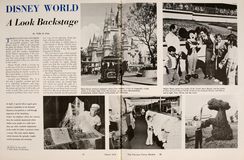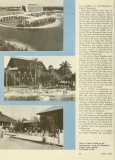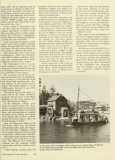THERE'S ENOUGH LAND HERE to hold all the ideas and plans we can possibly imagine," said Walt Disney back in 1964 as he discussed his plans for Disney World. "With the technical know-how of American industry and the creative imagination of the Disney organization, I am confident we can build a living showcase that more people will talk about and come to look at than any other area in the world."
Disney World, which is moving up to the top of the list of destinations of greatest interest to Panama Canal employees heading for family vacations in the United States, is living up to all of Walt Disney's expectations.
Located near Orlando, Fla., it is not only a popular vacation spot but it is attracting architects and engineers, who want to take a look behind the scenes and see how it all works and works so well. They come to learn how ecological problems have been solved, new ways of city planning, about garbage collection and flood control.
One of the ideas in which there is great interest is Disney World's basement which covers 8 acres. Disney World, boasts that it has the largest basement in Florida.
This vast service area, which spreads beneath the entire park, is where all the water, electric, and sewage lines are concealed but located so that they are readily accessible for repair. Disney made sure that the sound of the jack hammer, taking up pavement to repair a broken water line, will never be heard in the Magic Kingdom.
[img]At right: A special effects expert peers around a candelabra in the Haunted Mansion as he performs a walk-through inspection of the funilshings. Center: An employee selects her costume from the wardrobe department which clothes more people on o daily basis than any other wardrobe department in the world. For right: A gardener waters a moose. The many topiary figures which decorate the grounds, require careful grooming and nurturing.[/img]
[img]Horse-drawn streetcars transport visitors from Main Street, U.S.A. to Cinderella's Castle which is 18 stories high. From this location, guests enter Adventureland, Frontierland, Liberty Square, Fantasyland and Tomorrowland.[/img]
[img]Mickey Mouse greets Luz Sedda, of the Canal's Rates Branch, and her family on their arrival at Disney World. At left are her husband, Ileman, and Melissa, and at right, Tony, David, and Ana Luisa.[/img]
Special supply-carrying tractors operate here so that no delivery trucks disturb the atmosphere above. Illusions can be preserved, since all costumes and dressing rooms are located here and visitors are spared the sight of a spaceman or a frontier guide rushing through the wrong theme park en route to his own. He can go through corridors and up stairs directly into his particular area, whether it is Adventureland or Land of Tomorrow.
More than 10,000 "actors" are costumed daily in the basement. This includes theme park employees, special entertainers, the famous Disney characters and the audio-animatronic figures in the eight major attractions that use this new patented Disney invention. In this system, voices, music, and sound effects are electronically combined and synchronized with the lifelike movements of three-dimensional objects ranging from birds and flowers to humans. These figures wear out costumes rapidly because of the many movements they are programed to make. The 36 Presidents of the United States in the Hall of Presidents, for instance, stand, sit, nod, turn and smile. Replacement parts for their costumes are included in the more than 1,000,000 different items in the wardrobe department.
Visitors to the Magic Kingdom think that it must be magical that no noisy garbage trucks are seen anywhere. This is made possible by the Swedish garbage system which whisks refuse by vacuum tubes from 15 stations within the park to a compacting plant hidden from view outside the gates. Even the service basement has no garbage trucks and they will never be needed anywhere in the theme park area. The system is capable of handling .50 tons of refuse daily. Architects think that this system could be adapted for use in new suburban areas now being developed.
Disney World's environmental protection operation is very thorough concerning air and water pollution control. This falls under the supervision of a former Governor of the Canal Zone, William E. Potter, who has the title of chairman of the Reedy Creek Improvement District. Reedy Creek, controlled by the Disney organization, sets air and water pollution standards, and handles many other diverse functions.
An enormous computer supervises the whole operation and provides a fire monitoring system that is tied into Disney World's own fire department. It also monitors all rides and mechanical devices throughout the park, automatically shutting down any equipment that malfunctions.
[img]Hotels at Disney World are the Contemporary, at top, the Polynesian Village, center, and the Golf Resort, at left.[/img]
All of this, of course, is to support the Magic Kingdom, the amusement park itself, and an important part of maintaining its illusions is that everything works and works well. There are no blackouts and the trains, trams, and boats all work efficiently and on time. Although the daily volume of visitors exceeds 50,000 people, who discard about a pound and a half of litter each, the streets stay clean.
Young visitors to Disneyland often wish they could stay overnight in the magical atmosphere. At Disney World this is possible as there are three unique hotels, the 1,057-room Contemporary Resort Hotel, the 500-room Polynesian, and the 151-room Golf Hotel.
Later, as part of a 5-year plan, several other resorts will be added, including themes from the Old West, Venice, Asia and Persia. All will overlook the Seven Seas Lagoon or 450-acre Bay Lake.
Most spectacular of the resorts is the Contemporary, which has convention and exhibit facilities, including restaurants and entertainment areas, shops, nightclubs, beaches and a marina.
The Contemporary tower is an unusual building in many ways. It was constructed of preassembled room units overlooking an inner-concourse so vast it is called the "Grand Canyon."
The concourse is much like an outdoor park that has been moved indoors. At its center is a four-sided tile mural nine stories high, depicting the colors and patterns of the Grand Canyon. Called "The Pueblo Village" it covers 18,000 square feet, and is one of the world's largest murals.
Through the heart of this busy concourse travels the silent, all-electric monorail carrying guests to the Magic Kingdom, to the main parking area and to the Polynesian Village.
At the Polynesian Village, guest rooms are nestled in three-story "long- houses" arranged around a picturesque marina with quiet beaches, broad green lawns, and swaying palms to complete the island setting. Dining room menus in the Papeete Bay Veranda, overlooking the Seven Seas Lagoon, reflect the French heritage of Tahiti.
Near the Polynesian Village is the Golf Resort Hotel with two 18-hole championship golf courses, the Magnolia and The Palm. Clubhouse, dining room, practice green and driving range are available. A third course is planned.
Still another major vacation attraction is located on the south shore of Bay Lake. The 600-acre Fort Wilderness camping area has campsites nestled among pines and long winding water-ways.
Utility hookups, frontier store and recreation centers are also among Fort Wilderness facilities and nearby is a private beach. Horseback riding is available at the Tri-Circle D Ranch with miles of woodland trails.
Parades, spectacular water shows, and holiday extravaganzas complete the total entertainment concept. Its nightly fireworks displays make Disney World the largest user of fireworks in the world.
The gateway to Walt Disney World is located 20 miles southwest of Orlando on U.S. Highway 192, just west of Interstate 4. Guests not staying at Disney hotels travel 4 miles across the Disney property to a day-visitor parking area for 12,000 vehicles. Nearby is a STOLport for short takeoff and landing airplane service to areas in Florida.
Trams take guests from their cars to the main entrance complex on the south shore of the lagoon. This complex includes the Kal Kan Kennel Club pet motel where everything, from pet raccoons to pet lions, has been boarded, and the guest relations offices.
Nearly a mile away to the north can be seen the Victorian-style station of the Walt Disney World Railroad where steam trains, trams or 500-passenger ferryboats can be found.
But the most appealing single feature of the whole operation is not mechanical. It is about 9,000 people, most 22 years old or younger, who make up the staff, all extremely bright, good looking, and eager to please. There doesn't seem to be a sullen, disagreeable employee in the lot and when they greet new arrivals with "Have a Happy Day," it tends to convince adults as well as children that they have escaped into a different world.
Other phases of the development of the Disney property include a unique, leisure-oriented residential community, industrial parks and in the future, EPCOT-the Experimental Prototype Community of Tomorrow.
Walt Disney envisioned EPCOT as a living blueprint of the future— a community which could put into practical use the newest innovations and systems of American industry and technology. Many of the Phase I developments are already testing new ideas, forerunners of the imagination and pioneering spirit that perhaps one day will provide a model for a different type of community.
[img]A river boat cruises by Harpers Mill on Tom Sawyer Island. Disney World has its own fleet of more than 200 vessels, including sternwheel steamboats, canoes, rafts, and submarines.[/img]


